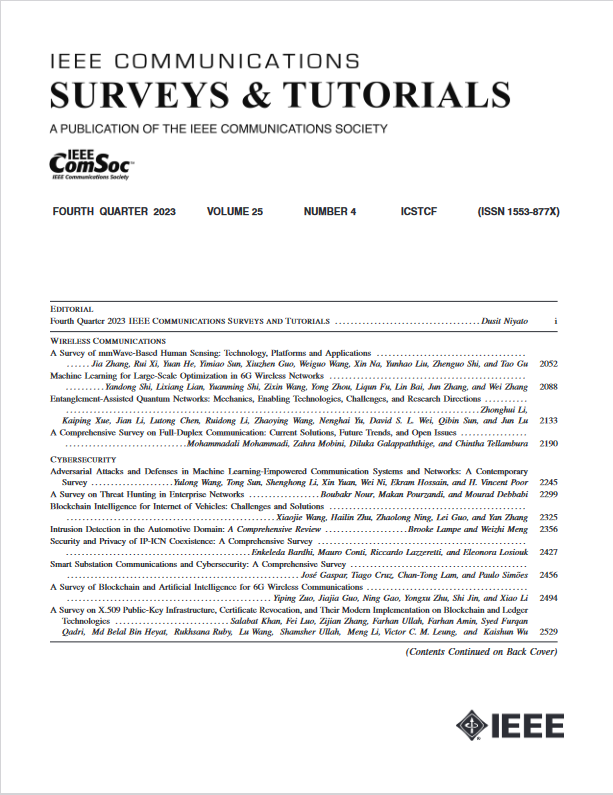Federated Learning-Empowered Mobile Network Management for 5G and Beyond Networks: From Access to Core
IF 34.4
1区 计算机科学
Q1 COMPUTER SCIENCE, INFORMATION SYSTEMS
引用次数: 0
Abstract
The fifth generation (5G) and beyond wireless networks are envisioned to provide an integrated communication and computing platform that will enable multipurpose and intelligent networks driven by a growing demand for both traditional end users and industry verticals. This evolution will be realized by innovations in both core and access capabilities, mainly from virtualization technologies and ultra-dense networks, e.g., software-defined networking (SDN), network slicing, network function virtualization (NFV), multi-access edge computing (MEC), terahertz (THz) communications, etc. However, those technologies require increased complexity of resource management and large configurations of network slices. In this new milieu, with the help of artificial intelligence (AI), network operators will strive to enable AI-empowered network management by automating radio and computing resource management and orchestration processes in a data-driven manner. In this regard, most of the previous AI-empowered network management approaches adopt a traditional centralized training paradigm where diverse training data generated at network functions over distributed base stations associated with MEC servers are transferred to a central training server. On the other hand, to exploit distributed and parallel processing capabilities of distributed network entities in a fast and secure manner, federated learning (FL) has emerged as a distributed AI approach that can enable many AI-empowered network management approaches by allowing for AI training at distributed network entities without the need for data transmission to a centralized server. This article comprehensively surveys the field of FL-empowered mobile network management for 5G and beyond networks from access to the core. Specifically, we begin with an introduction to the state-of-the-art of FL by exploring and analyzing recent advances in FL in general. Then, we provide an extensive survey of AI-empowered network management, including background on 5G network functions, mobile traffic prediction, and core/access network management regarding standardization and research activities. We then present an extensive survey of FL-empowered network management by highlighting how FL is adopted in AI-empowered network management. Important lessons learned from this review of AI and FL-empowered network management are also provided. Finally, we complement this survey by discussing open issues and possible directions for future research in this important emerging area.面向 5G 及更高网络的联合学习驱动型移动网络管理:从接入到核心
根据设想,第五代(5G)及以后的无线网络将提供一个集成的通信和计算平台,在传统终端用户和垂直行业日益增长的需求推动下,实现多用途智能网络。这一演进将通过核心和接入能力的创新来实现,主要来自虚拟化技术和超密集网络,如软件定义网络(SDN)、网络切片、网络功能虚拟化(NFV)、多接入边缘计算(MEC)、太赫兹(THz)通信等。然而,这些技术要求增加资源管理的复杂性和网络切片的大型配置。在这一新环境中,网络运营商将借助人工智能(AI),以数据驱动的方式实现无线电和计算资源管理与协调流程的自动化,从而努力实现人工智能赋能的网络管理。在这方面,以往大多数人工智能驱动的网络管理方法都采用传统的集中式训练范例,将分布式基站上与 MEC 服务器相关联的网络功能产生的各种训练数据传输到中央训练服务器。另一方面,为了快速、安全地利用分布式网络实体的分布式并行处理能力,联合学习(FL)作为一种分布式人工智能方法应运而生,它可以在分布式网络实体进行人工智能训练,而无需将数据传输到集中式服务器,从而支持多种人工智能网络管理方法。本文全面探讨了从接入到核心的 5G 及更高网络的 FL 驱动型移动网络管理领域。具体来说,我们首先介绍了 FL 的最新进展,探索和分析了 FL 的总体发展情况。然后,我们对人工智能驱动的网络管理进行了广泛的调查,包括有关 5G 网络功能、移动流量预测以及核心/接入网络管理的标准化和研究活动的背景。然后,我们通过重点介绍人工智能网络管理中如何采用 FL,对人工智能网络管理进行了广泛的调查。我们还提供了从人工智能和 FL 驱动的网络管理回顾中汲取的重要经验。最后,我们讨论了这一重要新兴领域的开放性问题和未来可能的研究方向,以此补充本调查报告。
本文章由计算机程序翻译,如有差异,请以英文原文为准。
求助全文
约1分钟内获得全文
求助全文
来源期刊

IEEE Communications Surveys and Tutorials
COMPUTER SCIENCE, INFORMATION SYSTEMS-TELECOMMUNICATIONS
CiteScore
80.20
自引率
2.50%
发文量
84
审稿时长
6 months
期刊介绍:
IEEE Communications Surveys & Tutorials is an online journal published by the IEEE Communications Society for tutorials and surveys covering all aspects of the communications field. Telecommunications technology is progressing at a rapid pace, and the IEEE Communications Society is committed to providing researchers and other professionals the information and tools to stay abreast. IEEE Communications Surveys and Tutorials focuses on integrating and adding understanding to the existing literature on communications, putting results in context. Whether searching for in-depth information about a familiar area or an introduction into a new area, IEEE Communications Surveys & Tutorials aims to be the premier source of peer-reviewed, comprehensive tutorials and surveys, and pointers to further sources. IEEE Communications Surveys & Tutorials publishes only articles exclusively written for IEEE Communications Surveys & Tutorials and go through a rigorous review process before their publication in the quarterly issues.
A tutorial article in the IEEE Communications Surveys & Tutorials should be designed to help the reader to become familiar with and learn something specific about a chosen topic. In contrast, the term survey, as applied here, is defined to mean a survey of the literature. A survey article in IEEE Communications Surveys & Tutorials should provide a comprehensive review of developments in a selected area, covering its development from its inception to its current state and beyond, and illustrating its development through liberal citations from the literature. Both tutorials and surveys should be tutorial in nature and should be written in a style comprehensible to readers outside the specialty of the article.
 求助内容:
求助内容: 应助结果提醒方式:
应助结果提醒方式:


